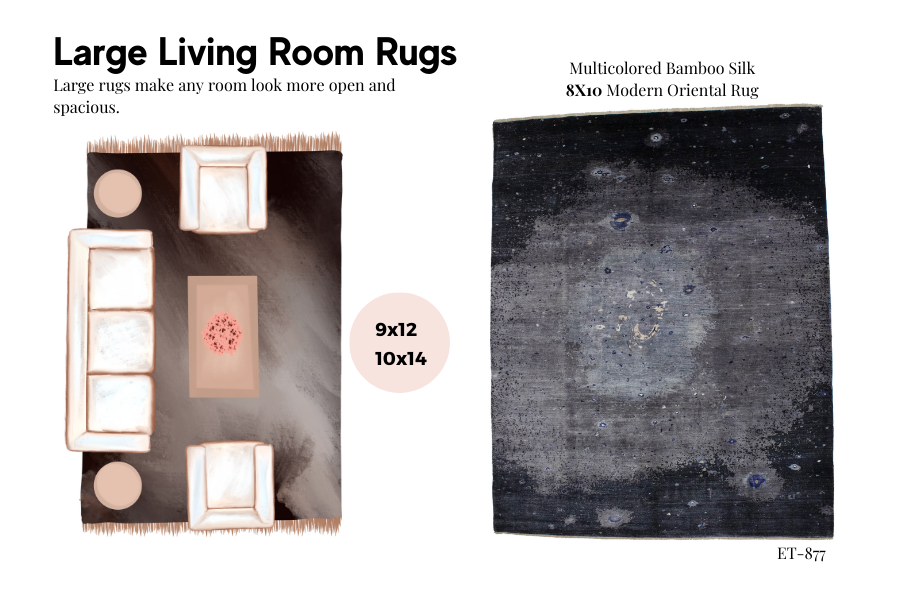Rugs are a wonderful way to add warmth, color, and texture to your living room. Whether you have a large or small space, a rug can help to define the area and anchor your furniture. When it comes to placing a rug in your living room, there are a few things to consider to ensure that it looks its best. In this blog post, we’ll share some tips and guidelines to help you choose and place the perfect rug in your living room. We’ll cover topics such as size, shape, material, and placement, to help you create a cohesive and stylish space. By the end of this post, you’ll have all the knowledge you need to confidently choose and place a rug in your living room.

To place a handmade area rug in your living room, follow these steps:
- Measure the size and shape of the room: Use a tape measure to determine the dimensions of the room in feet or meters. Make sure to measure from wall to wall, including any alcoves or recesses.
- Determine the size and shape of the rug you need: Consider the size and layout of the room and the furniture you have in it when deciding on the size and shape of the rug. A larger rug can help to anchor a seating area and create a cohesive look, while a smaller rug can be used to define a specific area or add a pop of color.
- Choose a rug with a design that complements your decor: Consider the colors, patterns, and style of your furniture and decor when choosing a rug. Look for a rug that will complement these elements, rather than compete with them.
- Place the rug in the desired location: Unroll the rug and position it in the desired location in the room. Make sure to leave enough space around the edges of the rug so that it does not extend all the way to the walls of the room.
- Adjust the placement of the rug as needed: Once the rug is in place, step back and assess the overall look. If necessary, adjust the placement of the rug to achieve the desired effect.
Remember to have fun with your rug placement and don’t be afraid to experiment with different locations and layouts to find the look that works best for your space.
There are several reasons why you might want to learn how to place an area rug:
- Area rugs can be a significant investment, and proper placement can help to protect your investment and ensure that the rug lasts for many years.
- Area rugs can be used to define a space, anchor furniture, add color and pattern to a room, and protect flooring. Proper placement can help you to achieve these goals and create a cohesive and functional space.
- Area rugs can be a beautiful and decorative element in a room, and proper placement can help to highlight their beauty and enhance the overall look and feel of the space.
- Proper rug placement can help to create a sense of balance and harmony in a room and can make a space feel more cohesive and inviting.
Overall, learning how to place an area rug can be a useful skill that can help you to create a functional and stylish space in your home.
What size should you choose to place a rug in your living room?
The size of the area rug you should get for your living room will depend on the size of the room and the layout of your furniture. Here are a few general guidelines to help you choose the right size rug:
- For a small living room, choose a rug that is large enough to anchor the furniture, but not so large that it consumes the entire room. A 5′ x 8′ or 6′ x 9′ rug is a good option for a small living room.
- For a medium-sized living room, consider using a rug that is large enough to anchor the seating area, but still allows some of the floor to show around the edges. An 8′ x 10′ or 9′ x 12′ rug is a good option for a medium-sized living room.
- For a large living room, you can use a larger rug to anchor the seating area or create separate areas within the space. Consider using a 9′ x 12′ or 10′ x 14′ rug for a large living room.
Remember that these are just general guidelines, and the size of the rug you choose will ultimately depend on the size and layout of your living room and the furniture you have in it. It is a good idea to measure the space and use a piece of paper or string to visualize the size of the rug before making a purchase.
What materials are handmade area rugs made of?
Area rugs can be made from a variety of materials, including wool, cotton, silk, faux-cowhide leather, and bamboo. Each type of material has its own unique properties and benefits, so it is important to consider which one is the best fit for your needs.
Choosing the right material for your rug is important for a number of reasons. The material of a rug can affect its durability, appearance, and feel, so it is important to consider which type of material is the best fit for your needs. Here are a few things to consider when choosing the material for your rug:
- Durability: Different materials have different levels of durability, so it is important to consider how much wear and tear the rug will be subjected to. For example, wool rugs are generally more durable than cotton rugs and are a good choice for high-traffic areas.
- Appearance: The material of a rug can also affect its appearance. Wool rugs, for example, are known for their soft, plush feel and natural sheen, while cotton rugs are often more casual and lightweight. Consider and decide on the look that you want for your room when placing a handmade rug.
- Feel: The material of a rug can also affect its feel underfoot. Wool rugs are generally softer and more comfortable to walk on, while synthetic materials may be smoother and more durable the difference in comfort is considerably noticeable. Consider the comfort level that you want when choosing a material for your handmade area rug.
Overall, choosing the right material for your rug is important for ensuring that you get a rug that is durable, looks great and feels comfortable. Consider your specific needs and preferences when choosing a material to find the best fit for your home.


